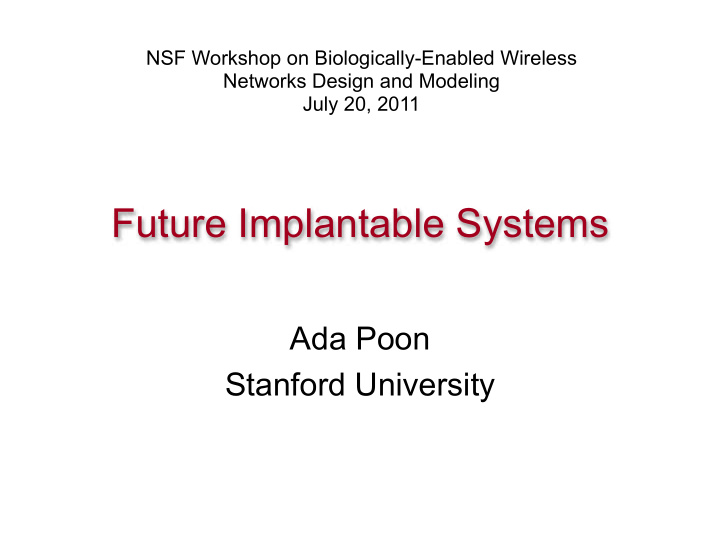



NSF Workshop on Biologically-Enabled Wireless Networks Design and Modeling July 20, 2011 Future Implantable Systems Ada Poon Stanford University
Real Time, Distributed In Vivo Diagnostics Intracardiac Electrogram Moving implants Multielectrode epicardial Chip in cell for cellular- mapping for EP study level monitoring and Wireless endocardial therapeutic treatments pacing and sensing 10 µ m 100 µ m 1 mm Implant Dimension
Current Autonomous Implants Retinal implant Cochlear implant Endoscope [Lenaerts 07] [Wang 06] Use remote power source to remove the battery partially or completely. Power transmission is like a transformer – inductive coupling . Power receiver is large – 1 to a few cm. Extremely short distance (almost touching) Coil alignment is critical. Still, we haven’t solved the problem of miniaturization.
Can we do better than inductive coupling? Back to Physics … In the past 50 years, analyses on wireless power transmission within biological tissues omit the displacement current − the term Maxwell added to Ampere’s Law and resulted in the Maxwell equations. Lower frequency is better! Most systems operate at 10 MHz or lower. YES when we take into account the displacement current.
Tissue Model: Relaxation Loss Occur at high frequency in dielectrics, for example, biological media. Efficiency would not increase indefinitely with frequency. An optimal frequency exists. We are interested in where it is, MHz-range or GHz- range . Use Debye relaxation model: 22 0.5 MHz GHz
An efficiency metric that is valid in all field regions and is not contaminated by circuit parameters. Both magnetic flux and electric field are derived from vector field analysis, that is, no far-field or near-field approximation.
Optimal frequency is in the GHz-range! Tissue Type Freq (GHz) Tissue Type Freq (GHz) Kidney 3.81 Blood 3.54 Lens cortex 3.93 Bone (cancellous) 3.80 Liver 3.80 Bone (cortical) 4.50 Lung 4.90 Brain (grey) 3.85 Muscle 3.93 Brain (white) 4.23 Skin 4.44 Fat (infiltrated) 6.00 Spleen 3.79 Fat (not infiltrated) 8.64 Tendon 3.71 Heart 3.75
Planarly Layered Body Model 2 cm TX coil d 1 = 10 mm, skin thickness 2 mm, fat thickness 5 mm Sommerfeld integration Optimal frequency remains in the GHz range.
Simulated & Measured Optimal Frequency Skin Fat Muscle Tissue Phantom 2 cm Measured
Implemented System
Prototype Receiver at .13 µ m CMOS Operating frequency 915 MHz or 1 GHz TX antenna size 20 mm × 20 mm RX antenna size 2 mm × 2 mm Inter-antenna dielectric 15 mm, bovine muscle tissue Startup time 4 µ s Rectifier efficiency 65% Regulator efficiency 70% Gain of link + rectifier + regulator -33.2 dB (theoretical 31.0 dB) DC output power 140 µ W @ 1.2 V regulated ISSCC 09 Unique features Adaptive conjugate matching Highly efficient rectifier Coil dimension is 2 mm × 2 mm which is 100 times smaller than previous designs in the literature at the same power transfer efficiency and range.
1959 , Richard Feynman, Plenty of Room at the Bottom :
Current Propulsion Methods [Li 08] 4µm Mechanical methods Passive methods Suffers from low conversion Requires complex field generation efficiency from mechanical motion e.g. gradient, rotating, and to forward thrust. oscillating fields. Requires high power Requires precise 3D control of e.g. 1 mW for 1 cm/s fields. Moving parts increase complexity. Slow at small sizes
Convert Electrical Power Directly to Thrust Mechanical methods Electrical Energy to Mechanical Motion to Wireless Power Mechanical Motion Thrust Source Introduces Loss Very Inefficient at Low Reynolds Proposed electromagnetic method Electrical Current to Wireless Power Thrust Force Source
How does it work? Inspired by product rule in differentiation … In the passive propulsion method, we keep m constant and vary B . It circumvents the power and efficiency issues but require a precisely controlled, large field gradient. Now, we vary m and keep B constant.
Power-Efficient Torque Generation Magne0c ¡Moments Currents B-‑field Current loops on the implant can generate magnetic moment in any 3D direction. Generated magnetic moment experiences a torque to align it with an external static magnetic field.
Translating Torques into Motion Top View Small Drag Force Current Reverse EM Torque Loop Net Force Current Net Force Large Drag Force Idea is similar to the paddle in kayaking. Asymmetrical shape produces asymmetrical drag forces. Alternate direction of EM torque results in net forward force. Device can be optimized in terms of shape, frequency of current switching, and magnitudes of currents.
Fluid Simulation For a 1-mm device in a 0.5-T static field, the current to achieve an angular frequency of 10 Hz is about 10 mA. Thrust force produced corresponds to stead-state velocity of 1 cm/s. Current required corresponds to power consumption of 100 µW.
Preliminary Experiments
System-Level Block Diagram Implantable Device V cc Rectifier Transmitter (Power Supply) Power Data Demodulation Controller Propulsion (downlink) Unit System Data (mod and demod) Load Modulation Functional Units/ (uplink) Sensors/etc Power and data are transmitted from same antenna Propulsion dominates power consumption, and must be efficient. Taped out in June
Wireless Probing of the Heart In the United States, about half of the cardiac mortality is due to ventricular arrhythmia, which accounts for approximately 300,000 deaths per year. Intracardiac Electrogram
Building Blocks
CHIC (CHip In Cell) Autonomous, wireless, implantable sensor Active, continuous-time monitor of cellular activity Source: T. Johnson, B. Reutter Lung cancer cell 25 µm 2 chip 50 µm DETECTION SYSTEM
Conclusions Optimal frequency for wireless power transfer over biological tissue is about 2 order of magnitude higher than conventional wisdom. As a result, the implant dimension can be reduced by 100 times in area. Wireless and miniature implants will introduce a new way to in vivo diagnostics and therapeutic treatment. Intracardiac Electrogram
Recommend
More recommend